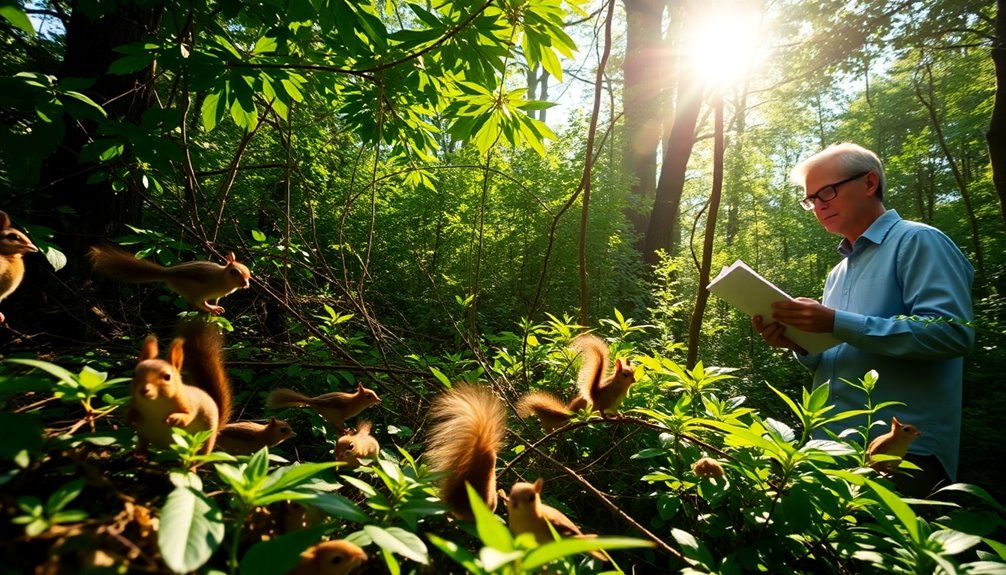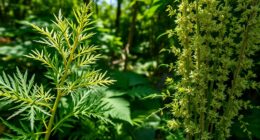Optimal Foraging Theory (OFT) is essential because it offers insights into how organisms make foraging decisions to maximize their energy efficiency and survival. You'll learn that this theory helps explain animal behavior, environmental adaptations, and even human strategies in resource management. Understanding OFT enables you to appreciate the balance between energy intake and expenditure, influenced by factors like food availability and competition. It also sheds light on the impact of climate change and habitat loss on foraging methods. By grasping these concepts, you're better equipped to explore their broader implications across various fields.
Key Takeaways
- Optimal Foraging Theory (OFT) predicts feeding behaviors, influencing population dynamics and ecosystem health in various species.
- OFT informs conservation strategies by identifying critical habitats essential for the survival of endangered species.
- The theory aids in understanding human decision-making and learning processes, linking ecological principles to psychology.
- OFT's applications extend to archaeology, revealing ancient human foraging strategies and informing historical dietary practices.
- Insights from OFT enhance agricultural pest management, optimizing crop protection and resource use for sustainable practices.
Overview of Optimal Foraging Theory

What drives animals to choose one food source over another? This question lies at the heart of Optimal Foraging Theory (OFT), which predicts that animals make foraging decisions to maximize their fitness. By focusing on energy gain while minimizing energy expenditure, animals adapt their foraging behavior to enhance their chances of survival.
OFT introduces the concept of currency, emphasizing that profitability is determined by the energy gained divided by the handling time of prey items. Key models like the Marginal Value Theorem help explain how animals assess food availability and adjust their foraging strategies accordingly.
For instance, when food becomes scarce, animals may stay longer at a location to maximize energy gain, while in abundant conditions, they quickly move on to new sources. This adaptability also plays an essential role in predator-prey dynamics, as it influences how species interact within their ecological communities.
Key Components of Foraging Models

Ideal Foraging Theory (OFT) incorporates several key components that drive foraging decisions in animals. One critical aspect is currency, which often represents energy gain per unit time (E/T) or resource uptake (R/T). This helps you evaluate the efficiency of your foraging strategy.
The Optimal Diet Model plays an essential role, guiding foragers to decide which prey to pursue, based on their energy gain relative to handling time (E/h). In this model, you need to take into account trade-offs between the energy gained and the time spent handling the prey.
Prey density also influences these decisions, as higher densities can lead to increased encounter rates, impacting net energy gain. Decision rules dictate when to search for or handle resources, balancing the benefits of energy gain against risks like competition or predation.
Influencing Factors on Foraging Behavior

Foraging behavior is shaped by a variety of internal and external factors that dictate how animals search for food. Internal physiological traits, like hunger levels and metabolic rates, influence your foraging patterns and prey preferences. If you're hungry, you'll likely prioritize high-energy foods, adjusting your search based on what's available.
External factors, such as environmental variables and prey availability, also play a vital role. For instance, if a habitat has abundant prey, you might change your strategy to maximize energy intake. However, competition with other foragers can complicate this; you may need to adapt your tactics to secure resources.
Predation risk further complicates your decision-making. Often, the need for safety outweighs the benefits of high energy gain, leading you to forage in safer areas or at different times.
Additionally, the presence of parasites can steer you away from certain prey types that pose health risks. Ultimately, the trade-offs between energy intake and other essential behaviors—like reproduction and predator avoidance—illustrate the complexity of foraging behavior.
These factors intertwine within ideal foraging theory, guiding your choices in the ever-changing landscape of survival.
Evolutionary Patterns in Foraging

As you explore evolutionary patterns in foraging behavior, you'll find that strategies often emerge independently across diverse species. For instance, sit-and-wait foraging has evolved in various clades, like cordylid lizards, showcasing how ecological niches shape foraging decisions. Research highlights that foraging behavior is evolutionarily plastic, adapting to prey availability and environmental conditions, indicating significant historical influences. Furthermore, the foraging range of different species can greatly influence their foraging strategies and success.
To illustrate the diversity of foraging strategies, consider the following table:
| Species Type | Foraging Strategy | Energy Gain Method |
|---|---|---|
| Cordylid Lizards | Sit-and-wait | Low movement, high efficiency |
| Iguania Lizards | Active foraging | High movement, variable success |
| Trout (Juvenile) | Opportunistic feeding | Adapts to energy needs |
| Trout (Adult) | Selective foraging | Focus on high-calorie prey |
| Desert Animals | Bimodal foraging | Adjusts to water and food scarcity |
Phylogenetic mapping reveals bimodal foraging strategies in specific ecosystems, illustrating adaptive evolution in response to ecological niches. Additionally, ontogenetic shifts in foraging behavior, like those seen in trout, highlight how energy gain and predation risks influence strategies as organisms grow.
Applications Across Disciplines

Numerous disciplines benefit from the insights offered by Optimal Foraging Theory (OFT), which provides a framework for understanding how organisms make decisions about resource acquisition.
In ecological research, OFT predicts feeding behaviors that influence population dynamics and species coexistence, as competitive interactions often hinge on food availability.
In psychology, OFT enhances our understanding of decision-making processes, learning, and memory by modeling how organisms maximize resource acquisition in different environments.
Archaeologists also utilize OFT to analyze ancient human foraging strategies, revealing patterns of resource selection and energy expenditure that illuminate dietary practices of the past.
Moreover, OFT has significant implications for agricultural pest management. By predicting consumer behavior in relation to food density, it helps develop strategies that minimize crop damage while maximizing pest control.
Additionally, in conservation efforts, OFT identifies critical habitats and foraging patterns of endangered species, aiding in habitat protection and management strategies to improve survival rates.
Limitations and Challenges Ahead

As you explore Ideal Foraging Theory, you'll notice that environmental changes and behavioral constraints can greatly impact foraging strategies.
The models often fall short in predicting real-world behaviors, especially in the face of rapid climate shifts. These limitations highlight the need for a more nuanced understanding of how various factors shape foraging decisions.
Environmental Change Impacts
Rapid environmental changes pose considerable challenges to ideal foraging strategies, disrupting the delicate balance of resource availability and predator-prey dynamics. As climate change and habitat destruction reshape landscapes, you'll notice that foraging efficiency often declines. Altered temperature and precipitation patterns affect prey distribution, forcing you to adapt or migrate to secure your energy intake.
Invasive species further complicate the competitive landscape, making it harder for native species to thrive. This shift can lead to declines in populations, impacting overall ecosystem health. Even if you exhibit behavioral plasticity, it mightn't keep pace with these rapid changes, leading to mismatches between your foraging behavior and the resources available.
Empirical studies show that as environments become less predictable due to anthropogenic influences, the assumptions of Ideal Foraging Theory may not hold. Consequently, you may need to rethink your strategies to navigate these dynamic challenges.
Ultimately, the impacts of environmental changes on foraging strategies can considerably affect your fitness and reproductive success, highlighting the need for more complex models that address these emerging realities. Adaptation is essential in this ever-changing landscape.
Behavioral Constraints on Foraging
Changes in the environment can seriously complicate your foraging efforts, but behavioral constraints also play a significant role in shaping how you hunt for food. These constraints often stem from physiological limitations and environmental factors that challenge your ability to find and exploit prey effectively.
Consider these key points:
- Physiological limitations: Your energy reserves and digestive capacity can limit the types and amounts of prey you can consume.
- Resource availability: Changes in habitat structure and prey density can make ideal foraging difficult, forcing you to adapt your strategies.
- Predation risk: Choosing safer foraging locations might protect you but can also reduce your access to food, leading to tough trade-offs between energy intake and survival.
- Competition: Rival foragers can limit access to desirable prey, pushing you to be more selective or even shift to less ideal food sources.
These behavioral constraints mean that you often have to balance immediate needs with long-term survival, adapting your foraging behavior in response to ever-changing conditions.
Understanding these dynamics can enhance your foraging success and guarantee you stay nourished while traversing the challenges ahead.
Model Predictive Limitations
When applying Ideal Foraging Theory (OFT) to real-world scenarios, you'll often encounter significant limitations that can skew predictions about foraging behavior. One major challenge is the predictive limitations of OFT, which often oversimplifies complex interactions like predation risk and competition. These factors can drastically alter foraging strategies and efficiency, leading to discrepancies between theoretical predictions and the empirical data you observe in nature.
Moreover, environmental variability can introduce unpredictable variables that the models don't account for, making it difficult to apply OFT effectively in practical situations. This inconsistency between theory and reality necessitates a reevaluation of the identified currencies and constraints influencing foraging behavior.
To enhance the applicability of OFT, ongoing research is essential for refining models. This includes integrating additional factors, such as self-medication behaviors and how rapid environmental changes impact foraging strategies.
Future Research Directions

As researchers dive deeper into Ideal Foraging Theory (OFT), several exciting avenues for future investigation are opening up. You can expect a shift in focus towards understanding how self-medication behaviors influence foraging strategies. This emerging perspective reflects the growing recognition of animal health in resource utilization.
Consider these key areas for future research:
- Investigating the ecological correlates of various foraging modes, adapting to environmental changes.
- Conducting more empirical studies to validate theoretical models, especially in ecosystems affected by climate change and habitat loss.
- Utilizing GPS tracking and remote sensing technologies to gain insights into movement patterns and foraging dynamics in wild populations.
- Exploring the genetic basis of foraging strategies to understand evolutionary pressures across species and environments.
Frequently Asked Questions
Why Is the Optimal Foraging Theory Important?
The Ideal Foraging Theory's important because it helps you understand how animals make feeding decisions to maximize energy gain while minimizing effort.
By studying these behaviors, you gain insights into their survival strategies and ecological dynamics. It also informs conservation efforts, guiding you in identifying critical habitats for wildlife.
Plus, its principles extend to other fields, enhancing your understanding of decision-making in resource allocation across various contexts, from psychology to economics.
Why Is It Important to Study Foraging Behavior?
Studying foraging behavior is essential because it reveals how animals make decisions to maximize energy intake, impacting their survival and reproduction.
By understanding these behaviors, you can gain insights into predator-prey dynamics and community structures, which helps predict species interactions and ecosystem health.
It also aids in wildlife management and conservation efforts.
Ultimately, examining foraging offers a window into adaptability and evolutionary responses, vital in the face of environmental changes like climate change.
What Is the Significance of Foraging?
Foraging's significance lies in its direct impact on survival and fitness.
When you understand how animals search for food, you see its effects on energy intake and reproductive success. This behavior reveals how species adapt to their environments, influencing ecosystem dynamics.
What Does the Optimal Foraging Theory Predict?
Like a savvy shopper in a bustling market, you'll find that ideal foraging theory predicts how animals choose their prey based on energy efficiency.
It suggests you'll select prey with the highest energy gain compared to the time spent handling it. As prey density rises, you'll become more selective, often ignoring less profitable options.
Ultimately, it's about maximizing energy while minimizing effort, adapting your strategies to the availability and quality of resources around you.
Conclusion
In the grand tapestry of nature, ideal foraging theory weaves a tale of survival and adaptation. By understanding the delicate dance between organisms and their environment, you reveal a treasure trove of insights that span across disciplines. As you explore this fascinating theory, remember that it's not just about food; it's about the choices that shape life itself. Embrace the journey ahead, as future research promises to illuminate the shadows of our understanding, transforming the way you see the world.










